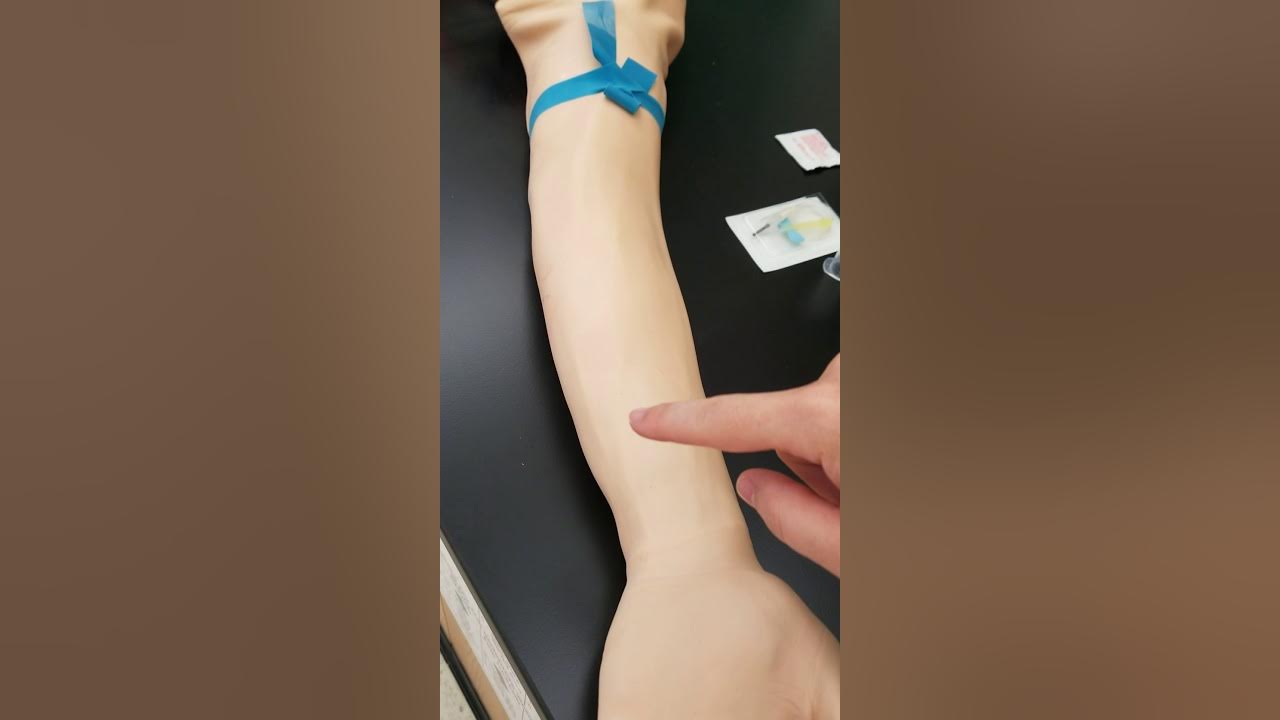Phlebotomy Lesson With My MA Students | Straight Needle
Summary
TLDRIn this educational video, the presenter demonstrates a live venipuncture lesson on a patient with an ideal vein. The process includes selecting the appropriate needle, applying a tourniquet, and finding the vein through palpation. The video emphasizes proper technique, such as not pumping the patient's arm to avoid altering test results, and maintaining a steady hand during the procedure. It also covers the importance of inverting blood collection tubes with additives and securing the needle after use to prevent accidents.
Takeaways
- 💉 The lesson is about performing a venipuncture on a real patient using a straight needle or vacutainer system.
- 🔍 Before starting, the patient's arm is checked to determine the appropriate needle size, with smaller veins requiring a butterfly needle.
- 👀 The patient has a visible and accessible vein, which is ideal for a successful venipuncture.
- 🤝 The tourniquet is applied 3 to 4 inches above the elbow, and is not left on for more than a minute to prevent discomfort.
- ✊ The patient is asked to make a fist to make the vein more prominent, but not to pump the fist as it can alter blood results.
- 👐 The vein is palpated gently to confirm its location and feel; it should be spongy and bounce back when touched.
- 🧼 The site is cleaned using a circular motion, starting from the point of insertion and moving outward.
- 📦 All supplies are prepared and organized before starting the procedure to ensure a smooth and efficient process.
- ✂️ The tourniquet is the last step before inserting the needle, and the patient's arm is positioned to stabilize the vein.
- 🩸 The needle is inserted with the bevel up, and the tube is filled with blood, which is then removed carefully to avoid needlestick injury.
- 🔄 After drawing blood, the tube is inverted a specific number of times depending on the additive it contains to ensure proper mixing.
Q & A
What is the purpose of the video?
-The purpose of the video is to demonstrate a live lesson on phlebotomy, which involves drawing blood from a patient.
Why is it important to check the patient's arm before starting the procedure?
-Checking the patient's arm is important to determine the appropriate needle size, especially for pediatric or geriatric patients with small or fragile veins.
What is the significance of the vein's appearance in the video?
-The vein's appearance is significant because a prominent and spongy vein is easier to access, making the phlebotomy procedure more straightforward and less painful for the patient.
Why should the tourniquet be tied 3 to 4 inches above the elbow?
-The tourniquet should be tied 3 to 4 inches above the elbow to provide sufficient pressure without cutting off circulation, and to ensure the veins are accessible for needle insertion.
What is the reason for having the patient make a fist during the procedure?
-Having the patient make a fist helps to make the veins more prominent, which can facilitate easier needle insertion and blood draw.
Why is it advised not to have the patient pump their fist?
-Pumping the fist can alter the blood results, so it's advised to only have the patient make a fist without pumping to maintain the accuracy of the blood sample.
How long should the tourniquet be left on before it's considered too long?
-The tourniquet should not be left on for more than a minute to avoid unnecessary discomfort and potential complications.
What is the proper technique for cleaning the skin before needle insertion?
-The proper technique involves cleaning from the inside out in circular motions, focusing on the area where the needle will be inserted and then working outwards.
Why is it important to have all supplies ready before sticking the patient?
-Having all supplies ready prevents the needle from being moved unnecessarily, reducing the risk of contamination and ensuring a smooth procedure.
What is the significance of the order in which the blood collection tubes are set up?
-Setting up the blood collection tubes in the order of draw helps streamline the process, making it easier to pick up each tube in sequence and maintain an organized workflow.
Why is it crucial to apply pressure after the needle is removed?
-Applying pressure after the needle is removed helps to stop bleeding and prevent bruising at the puncture site.
How should the blood collection tubes be handled after drawing blood?
-After drawing blood, the tubes should be inverted a specific number of times as indicated by the tube's requirements to ensure proper mixing of the blood with the additive.
Outlines

Dieser Bereich ist nur für Premium-Benutzer verfügbar. Bitte führen Sie ein Upgrade durch, um auf diesen Abschnitt zuzugreifen.
Upgrade durchführenMindmap

Dieser Bereich ist nur für Premium-Benutzer verfügbar. Bitte führen Sie ein Upgrade durch, um auf diesen Abschnitt zuzugreifen.
Upgrade durchführenKeywords

Dieser Bereich ist nur für Premium-Benutzer verfügbar. Bitte führen Sie ein Upgrade durch, um auf diesen Abschnitt zuzugreifen.
Upgrade durchführenHighlights

Dieser Bereich ist nur für Premium-Benutzer verfügbar. Bitte führen Sie ein Upgrade durch, um auf diesen Abschnitt zuzugreifen.
Upgrade durchführenTranscripts

Dieser Bereich ist nur für Premium-Benutzer verfügbar. Bitte führen Sie ein Upgrade durch, um auf diesen Abschnitt zuzugreifen.
Upgrade durchführenWeitere ähnliche Videos ansehen

Skill Practice #1: Tourniquet Procedure Details

Phlebotomy: The Veins Used for Venipuncture

Perform a Venipuncture Collect a Venous Blood Sample Using the Vacuum Tube Method

10 menit bisa pasang infuse #infuse#cateter #perawat#kolaboratif#mandiri#keperawatan#poltekkes

Percobaan : Tekanan Udara

CARA MEMBUAT VIDEO PEMBELAJARAN DENGAN POWERPOINT || BELAJAR POWERPOINT
5.0 / 5 (0 votes)
